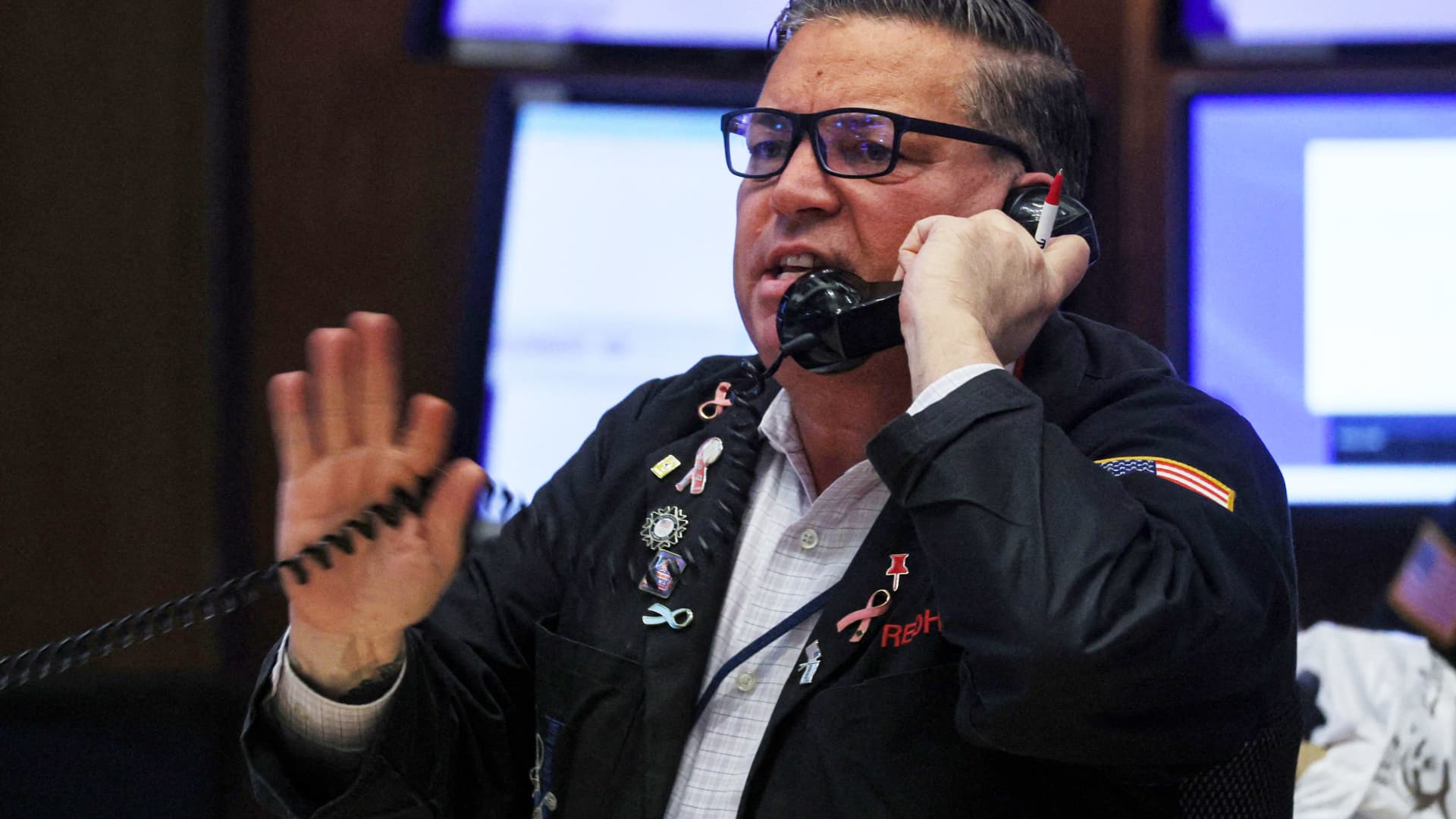
The bond market is sending a more urgent recession warning and also signaling that the Federal Reserve may have to pause raising interest rates — giving up its fight against inflation. The failure of Silicon Valley Bank and worries about broader contagion shook the bond market and sent rates tumbling. The 2-year Treasury yield fell about 100 basis points since Wednesday, its biggest three-day move since the stock market crash in October 1987. A basis point equals 0.01 of a percentage point. The sharp move in the 2-year yield also resulted in a rapid steepening of the yield curve. Yields fall when bond prices rise, and they moved quickly as spooked investors rushed to buy bonds in a volatile flight-to-safety trade. US2Y 1Y line 2 y The 2-year-to-10-year yield curve has been inverted for a while, meaning that 2-year yields are higher than the 10-year yield. This inversion is seen as a signal that the economy could be heading for recession. On Wednesday, the spread between both rates reached its widest level since 1981 at 111 basis points. The spread narrowed Monday to 47 basis points. “The deep inversion has been signaling a recession,” said Peter Boockvar, chief investment officer at Bleakley Financial Group. “The steepening always starts to happen because the market expects the Fed to cut rates in response to that recession.” The yield on the 2-year Treasury was at 4.01% Monday afternoon, while the benchmark 10-year yield was at 3.54%. The 2-year most closely reflects Fed policy, and there were parallel moves in the fed funds futures. Odds of a quarter-point rate hike for next week went from 100% last week to about 64% on Monday, said Boockvar. The market also has begun to price in 75 basis points of rate cuts for this year. “The steepening of 2s/10s begins the ‘Countdown to recession’ average 9 months from the inversion Max to recession start,” wrote Julian Emanuel, head of equity, derivative and quantitative strategy at Evercore ISI. DoubleLine Capital CEO Jeffrey Gundlach also said the “aggressively steepening” of the Treasury yield curve after inversion is “highly suggestive of imminent recession.” Gundlach previously said the 2-year 10-year yield curve started steepening before the past four economic downturns. Gundlach said the steepening, or narrowing of the spread, signals the timeline for a recession has moved up. The Nasdaq rose Monday as traders speculated the Fed will have to change its plans to keep rates high. The S & P 500 closed slightly lower. Emanuel expects the volatile stock market to retest its October lows. That would be consistent with the onset of recession, which is forecast for the second half of 2023. 10Y2YS 1Y mountain yield curve Economist Ed Hyman, chairman of Evercore ISI, said in a note that it would be a good idea for the Fed to pause its hiking because of the financial shock from the bank failures. Gundlach said he still expects the Fed to raise the fed funds rate range by a quarter point on March 22, but he said that could be the final hike. “This is really throwing a wrench into Jay Powell’s game plan…I think the inflation fight is temporarily being abandoned,” he said on CNBC. Goldman Sachs economists dropped their forecast for a quarter-point hike from the Fed next week. NatWest economists also said they also no longer expect a rate hike. The move in fed funds futures reversing some of the Fed’s rate hikes has been dramatic. Traders had even been pricing in the potential for a 50 basis-point hike after Fed Chair Jerome Powell’s comments last week. Powell on Tuesday told Congress that the Fed could have to raise rates even more than expected to bring inflation under control. That sent interest rates rising dramatically. On Wednesday, however, SVB announced it lost $1.8 billion on asset sales — marking the start of its demise. The U.S. government Sunday approved plans to safeguard depositors and financial institutions affected by the collapse of SVB. Customers will have full access to their funds at SVB and also a t Signature Bank , shut by New York regulators on Sunday . Kevin Cummins, chief U.S. economist at NatWest, has been expecting a recession in the second half of the year. He said the developments around the bank failures make it even more likely. “It would create downside risk from tighter lending standards and the fallout on the consumer and businesses as well,” he said. “From that channel, I would think you could make the case that the growth outlook is weaker as well.” End of rate hiking cycle? Cummins said the Fed now could be at the end of its tightening cycle, even though inflation remains high. A slower economy could result in an inflation slowdown as well. Barry Knapp, managing partner of Ironsides Macroeconomics, said the yield curve is not necessarily signaling a recession and that it could be inverted because Fed policy kept longer duration rates lower. But he does expect the Fed will have to make a policy response to end the worries around the banking system. “The main issue here is, I think, there’s going to have to be a monetary response,” he said. “I don’t think it means they have to cut rates, but I think it really means they have to pause right now.” Powell’s hawkishness last week added to the volatility in rates. The 2-year yield jumped above 5% after he spoke. “It was like he dropped a torpedo in the water, and he brought up a whale,” said Knapp.
